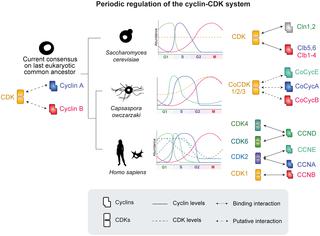PLOS Genetics ( IF 4.5 ) Pub Date : 2020-03-16 , DOI: 10.1371/journal.pgen.1008584 Alberto Pérez-Posada 1 , Omaya Dudin 1 , Eduard Ocaña-Pallarès 1 , Iñaki Ruiz-Trillo 1, 2, 3 , Andrej Ondracka 1

|
Progression through the cell cycle in eukaryotes is regulated on multiple levels. The main driver of the cell cycle progression is the periodic activity of cyclin-dependent kinase (CDK) complexes. In parallel, transcription during the cell cycle is regulated by a transcriptional program that ensures the just-in-time gene expression. Many core cell cycle regulators are widely conserved in eukaryotes, among them cyclins and CDKs; however, periodic transcriptional programs are divergent between distantly related species. In addition, many otherwise conserved cell cycle regulators have been lost and independently evolved in yeast, a widely used model organism for cell cycle research. For a better understanding of the evolution of the cell cycle regulation in opisthokonts, we investigated the transcriptional program during the cell cycle of the filasterean Capsaspora owczarzaki, a unicellular species closely related to animals. We developed a protocol for cell cycle synchronization in Capsaspora cultures and assessed gene expression over time across the entire cell cycle. We identified a set of 801 periodic genes that grouped into five clusters of expression over time. Comparison with datasets from other eukaryotes revealed that the periodic transcriptional program of Capsaspora is most similar to that of animal cells. We found that orthologues of cyclin A, B and E are expressed at the same cell cycle stages as in human cells and in the same temporal order. However, in contrast to human cells where these cyclins interact with multiple CDKs, Capsaspora cyclins likely interact with a single ancestral CDK1-3. Thus, the Capsaspora cyclin-CDK system could represent an intermediate state in the evolution of animal-like cyclin-CDK regulation. Overall, our results demonstrate that Capsaspora could be a useful unicellular model system for animal cell cycle regulation.
中文翻译:

Capsaspora 的细胞周期转录组学提供了对细胞周期蛋白-CDK 机制进化的见解。
真核生物细胞周期的进展在多个层面上受到调节。细胞周期进程的主要驱动力是细胞周期蛋白依赖性激酶 (CDK) 复合物的周期性活动。与此同时,细胞周期中的转录受到转录程序的调节,以确保基因的及时表达。许多核心细胞周期调节因子在真核生物中广泛保守,其中包括细胞周期蛋白和 CDK;然而,远缘物种之间的周期性转录程序是不同的。此外,许多保守的细胞周期调节因子在酵母中丢失并独立进化,酵母是细胞周期研究广泛使用的模式生物。为了更好地了解后康生物细胞周期调控的进化,我们研究了与动物密切相关的单细胞物种filasterean Capsaspora owczarzaki细胞周期中的转录程序。我们开发了Capsaspora培养物中细胞周期同步的方案,并评估了整个细胞周期中基因表达随时间的变化。我们鉴定了一组 801 个周期性基因,随着时间的推移,这些基因分为五个表达簇。与其他真核生物数据集的比较表明, Capsaspora的周期性转录程序与动物细胞最相似。我们发现细胞周期蛋白 A、B 和 E 的直系同源物在与人类细胞相同的细胞周期阶段以相同的时间顺序表达。然而,与这些细胞周期蛋白与多个 CDK 相互作用的人类细胞相反,Capsaspora细胞周期蛋白可能与单个祖先 CDK1-3 相互作用。因此,Capsaspora细胞周期蛋白-CDK 系统可能代表动物样细胞周期蛋白-CDK 调节进化的中间状态。总体而言,我们的结果表明Capsaspora可能是用于动物细胞周期调节的有用单细胞模型系统。

























 京公网安备 11010802027423号
京公网安备 11010802027423号